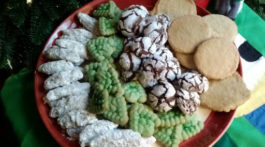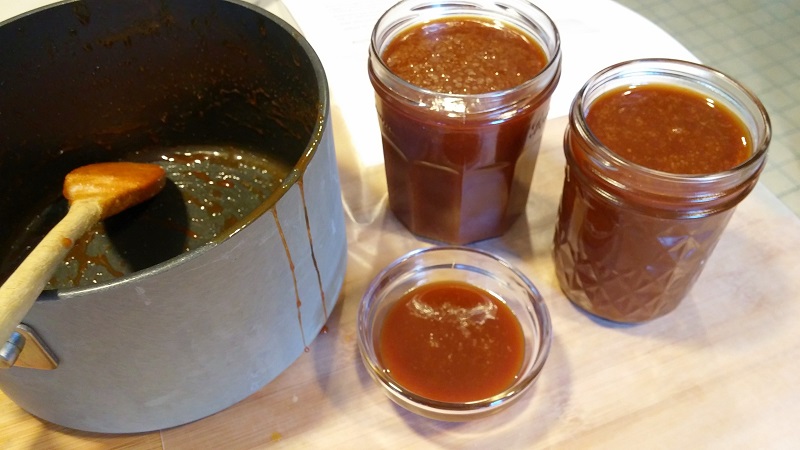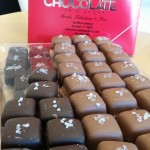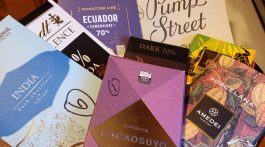I live in a chocolate centric world: chocolate candy, chocolate cake, chocolate truffles, hot chocolate, chocolate chip cookies, chocolate ice cream, chocolate fudge sauce, and even chocolate kisses. Handmade chocolates or a handful of M&Ms, it’s all irresistible to me. But lately another flavor has made inroads into my world of sweet vices.
Caramel – that deep, dark rich, almost-burned sugar – has entered the field. Caramel has always been there. It was a popular and well-known candy in early America. Easy to make from simple ingredients, it kept well and was widely popular. Hershey’s first commercial product distributed across the US in 1866 was a caramel candy, not chocolate.
Caramel has always been there in wrapped chewy candies and in popular bars like Milky Way, Twix, Snickers, O Henry and Mars Bar. But in the last few years it has stepped to the front of the stage in the form of salted caramel. These nuggets of caramel coated in chocolate and sprinkled with salt have taken my taste buds – along with most of
America’s – by storm. The coating can be dark or milk chocolate, the coarse salt can be from the sea, the mountains, smoked or delicate fleur de sel. Any combination is magic. I’m particularly seduced by the dark coated examples from Chocolate Rain on Wilton Ave. in Norwalk. www.chocolaterainshop.com)
It’s likely that the salted caramel was created in France and migrated across the Atlantic with pastry chefs coming to open high-end stores full of tempting confections – just like the chocolate truffle of a generation ago. Driven by their alluring flavor, salted caramel candy along with the salt and caramel flavor combination spread across the country to dessert menus, candy shops, and finally entered mass distribution. Americans can’t get enough. You can find salted caramel in ice cream, cheese cake, coffee drinks, brownies, cupcakes and more. I haven’t seen it yet on pizza, but your never know.
I’m a devotee of salted caramel candies, but along the way, I also discovered caramel sauce. The silken, dark brown sauce can bring silence around the table when served on ice cream. It’s handy to drizzle on cheesecake, shortcake or any other cake for that matter. You can even sprinkle a little salt on top for the salted caramel effect. I’m reluctant to admit that it may have replaced hot fudge as my go-to topping.
The best caramel sauce is homemade. The good news is that it’s simple to make and yields impressive results. Like our New England forefathers, we have the necessary ingredients on hand: sugar, cream and vanilla. I’ve taken to making a batch from time to time, usually enough for a jar to keep and a jar to give. My daughter says I’m always welcome at her house, but more so with a jar of caramel sauce in hand.
You don’t need much to make the sauce, and the method is pretty straight forward. Success is all about technique and practice. You boil the sugar until it is the right color, stir in the cream and add the vanilla
. The key part is to get the sugar the right color without going too far and burning it. The tricky part is to manage the process to prevent sugar crystals from forming and making the sauce lumpy. Practice, practice, practice, and do some tasting along the way. Visit www.FranksFeast.com for my recipe.
The sauce can be customized by substituting other flavors for the vanilla. Rum, bourbon or brandy can make a more grown up version. Extra salt can be added, but I prefer to sprinkle the salt on when serving for better crunchy, salty effect.
My interest in caramel sauce got me thinking about butterscotch sauce (another flavor that drizzles across American dessert culture) and the differences between the two. Since they’re the same color, I always wondered how they were different. Butterscotch, I learned, is made with brown sugar, butter, cream and vanilla, but does not involve the tricky caramelizing process. It’s popular, but it hasn’t enjoyed the renaissance of caramel.
I checked several sources and there was general agreement on the ingredients and method but considerable variation on the cooking time. The butter is melted and then the brown sugar, cream, and salt are stirred in. Bring the mixture to a gentle boil, but for how long? One source said three minutes, another called for five and the last suggested ten to twelve minutes. I went with five minutes, but after the sauce comes to a boil, it’s completely blended. I can only imagine that the longer it cooks, the thicker it gets. For my recipe visit www.FranksFeast.com.
Butterscotch doesn’t have the sophisticated complexity of caramel. That doesn’t mean that it’s not delicious on ice cream! And, its easier to make.
Caramel has not displaced my allegiance to chocolate. Instead it has added a whole new category of indulgence to be resisted. Woe is me!















No Comment